Josephine 4.25 x 3.5 Woodcut with Watercolor
Available on Etsy.
This woodcut was chosen for the Georgetown, Texas Arts & Culture program Current: Banner Project. Josephine (above) is one of fifty four banners on display in downtown Georgetown. The project was created and produced by Nick Ramos of Graphismo, and will be on display till November 20th, 2011.
The woodcut was carved from a block of Shina wood, inspired by beautiful photos of the entertainer Josephine Baker, and influenced by the illustrations of Jessie Willcox Smith (1863-1935) In the photo above, I’m testing the print, or making an Artists’ Proof – usually marked with A/P in the lower margin: ink was rolled onto my carved block and pressed against a small piece of Arches Cover paper so I could see if any more of the wood should be cut away.
After the block was inked and printed to complete the edition, the wood was cleaned and dried, and stored with a stack of others in a shoe box in my studio. When a limited edition is printed in full (in this case, there are 20 prints), the artist usually destroys the plate by carving a big X on the face of the block, or drilling holes in the corners. This ensures that no more then the edition of 20 are printed, and it’s called “striking the plate”. I prefer to burn my plates in a fire pit on chilly winter evenings with a glass of wine. It feels a little more ceremonious, and it keeps my feet warm. 🙂
So, now I have a nice little stack of woodcuts, and each one will be painted with watercolors in different shades, depending on my whims at the time. How about you? What have you printed lately?
Art Quote
For three centuries the fame of Velasquez has been growing until modern critics and artists have come to consider him, at least in regard of technique, the greatest of all painters. Whistler said of him that Art ” had dipped the Spaniard’s brush in light and air.” And Henri Regnault wrote, “Standing before a work of Velasquez, I feel as if I were looking at reality through an open window.” It is this sense of reality that impresses one in seeing a Velasquez. There have been painters with greater power to move the feelings, with a keener insight into the mystery of nature, with a magic quicker to kindle the imagination, with a brush dipped into tenderer, more somber, or more gorgeous colors, but none whose hand has held the mirror up to life more accurately. The artists in Rome thought that Velasquez alone painted reality, the others painted mere decorative convention.
He left no school of imitators, for who can imitate perfection? Yet his influence upon modern art is second to that of none. Regnault, Manet, CarolusDuran, Monet, Whistler, Degas, and Sargent have been his devoted admirers. “Corot and Millet,” writes F. A. M. Stevenson, ” took his principles into the open air; the first painting landscapes with figures, the second figures with landscapes.”
Diego Rodriguez Velasquez de Silva was born in Seville in 1599. He belongs to that era so productive of genius, the era of Shakspere, Cervantes, Montaigne, Kepler, Galileo, Tasso, Guido Reni, Rembrandt, Van Dyck, and Rubens. At thirteen we find him studying painting under Herrera; then for five years he studied under Pacheco, a man of learning but not a great master in art. He had a charming daughter, charming at least to the young Velasquez, for he married her. From teachers such as these, Velasquez absorbed all they had to give. In the house of Pacheco he met the artists, poets, scholars, and gentlemen of the city, and became conversant with the best of them in manners and culture.
In 1623, when he was 24 , he was summoned by Olivarez, the all-powerful minister of Philip IV, requesting the young artist to come to Madrid. Attended by his mulatto slave, Jean Parejo – who himself became so expert a painter that some of his work has been attributed to his master – Velasquez journeyed to Madrid. In a friend’s house he lodged and there painted a portrait which was soon carried to the palace by the son of a chamberlain of one of the princes. An hour later the prince, the king, and the king’s brother had gathered about the portrait in admiration, and the future of Velasquez was assured.
Sketches of Great Painters, by Edwin Watts Chubb 1915

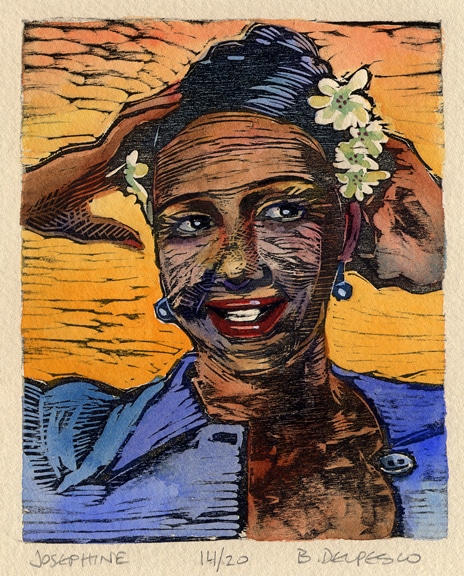
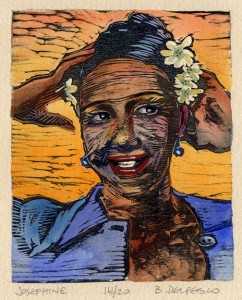
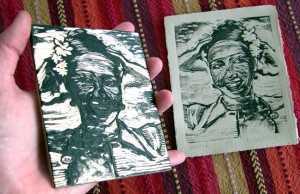
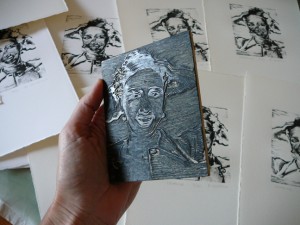
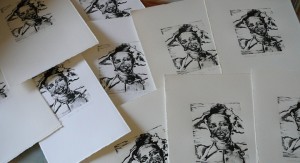
A woodcut…now you really are my hero!! Love it.
John
What a beautiful woodcut. I love the bright colors you used. I also like your tradition of getting rid of your wood after a printing group is done.
Hey Belinda… FIRST, I love this piece, and SECOND, I love that it’s included in the Banner Project down here in Texas!! SO COOL that we got a famous California artist!!! I actually went up to Georgetown last week to see the banners, but didn’t have a map or list of who was included and where. DARN it. I will have to go back and look for yours.
Beautiful Belinda. Congratulations. I love the banner idea.
xoxoxoxoxoxBarbara